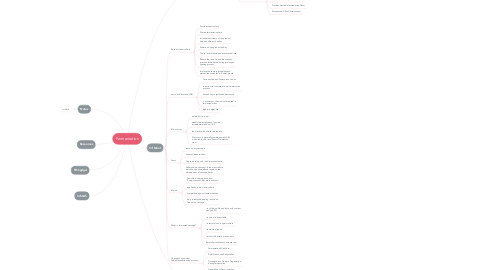
1. Notes
1.1. mbbjb
2. Resources
3. hfhhgdgd
4. hchhdh
5. Of Bakery Products
5.1. Yeast produces.
5.2. Types of yeast:
5.2.1. Fresh yeast
5.2.1.1. Active dry yeast
5.2.1.1.1. Instant yeast
5.3. Factors that affect yeast activity:
5.3.1. Fermentation time
5.3.1.1. Yeast growth
5.3.1.1.1. fermentative adaptation
5.4. Goals of fermentation:
5.4.1. Improves dough handling characteristics
5.4.2. Enhances gas retention in dough's
5.4.3. Enhances finished product texture
5.4.4. Provides desirable fermentation flavor
5.4.5. Extends shelf-life of final product
6. Of Meat
6.1. Role of starter culture
6.1.1. Ensure product safety
6.1.2. Shorten fermentation time
6.1.3. Increase consistency of the product between different batches
6.1.4. Achieve unique product quality
6.1.5. Control acidification and enhance shelf life
6.1.6. Reduce the risk of toxic histamine and tyramine fermentation during prolonged ripening process
6.1.7. Improve the sensory properties and prevent the unwanted microbial growth
6.2. Lactic acid bacteria (LAB)
6.2.1. Lactobacillus and Pediococcus strains
6.2.2. important for success of meat fermentation process.
6.2.3. have ability to synthesize bacteriocin
6.2.4. L. plantarum the most culture used in fermented meat
6.2.5. highly competitive
6.3. Micrococcus
6.3.1. isolated from meat
6.3.2. weekly fermentative and is active at temperature below 10°C
6.3.3. they reduce the nitrate very rapidly
6.3.4. Micrococci is generally combined with LABf or desirable color and flavor of fermented meat
6.4. Yeast
6.4.1. found on dry sausage
6.4.2. have not been smoked
6.4.3. help to develop color and improve aroma
6.4.4. Debaryomyces hansenii is the most culture has shown positive effects regard to the development of sausage flavor
6.5. Molds.
6.5.1. Penicillium chrysogenum and P.nalgiovense strains are a non-toxic
6.5.2. applied as mold starter culture.
6.5.3. competitive against contaminations
6.5.4. help in easy skin peeling in dry and fermented sausage
6.6. What is fermented sausage?
6.6.1. its pH below 5.6 and lactic acid content above 0.2%
6.6.2. its colour is heat-stable
6.6.3. its texture is no longer crumble
6.6.4. its aroma is typical
6.6.5. lactic acid bacteria predominate
6.6.6. Enterobacteriaceae counts are low
6.7. Changes during meat fermentation&ripening process:
6.7.1. Fermentation Microflora
6.7.2. Acidification and Dehydration
6.7.3. Proteolytic and Lipolytic Degradation during fermentation
6.7.4. Generation of Flavor volatiles
